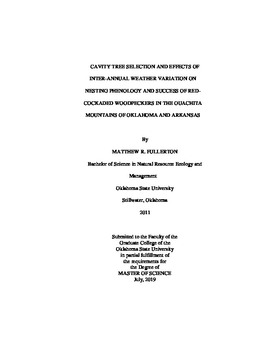| dc.contributor.advisor | Loss, Scott R. | |
| dc.contributor.author | Fullerton, Matthew R. | |
| dc.date.accessioned | 2020-01-30T19:46:37Z | |
| dc.date.available | 2020-01-30T19:46:37Z | |
| dc.date.issued | 2019-07 | |
| dc.identifier.uri | https://hdl.handle.net/11244/323392 | |
| dc.description.abstract | The Ouachita Mountains ecoregion in southeast Oklahoma and west-central Arkansas contains two populations of the red-cockaded woodpecker (Dryobates borealis, RCW), a federally endangered, cooperatively breeding species. Since the region is at the northwestern RCW range periphery, ecological thresholds are limiting for the species. To assess potential constraining factors for RCWs, we conducted a cavity tree selection analysis using data collected from 63 active cavity trees and 121 unused trees during 2017 - 2018. We also summarized attributes from active cavity trees and performed a chi-square analysis for directional cavity orientation. For cavity tree selection, we created single-variable generalized linear mixed models and used an AIC model comparison approach. Only one variable, canopy openness as measured from 0.5 m aboveground, was strongly supported. The χ2 analysis indicated that cavity trees generally had a northwest orientation. We found cavity tree selection to be based on high levels of canopy openness, and to a lesser extent, large tree crown areas. However, tree age was unimportant, likely due to the abundance of mature trees in our study area. | |
| dc.description.abstract | Inter-annual weather variation is predicted to increase with climate change, causing potential range shifts for many species. RCWs may be susceptible to the effects of climate change, especially at the northwestern range periphery in the Ouachita Mountains ecoregion. We used 26 years of nesting data (1991 – 2016) from two RCW populations in the region to determine how inter-annual weather variation affects nesting date, clutch size, and number of nestlings fledged. For each population, we used daily temperature and precipitation data from Oregon State University’s PRISM® network for 3 periods (30 and 60 days before nesting and 40 days overlapping nesting) to determine effects at the population level. For a separate analysis, we created smaller windows for individual RCW nests to determine how extreme weather events (i.e. “heat waves” and high precipitation events) affected overall nest success and partial brood loss. Single-variable generalized mixed models were used for the longer windows, and mixed models were created for nest-specific windows. AIC model comparisons were conducted separately for population- and nest-level analyses. RCWs for both populations experienced shifts in nesting dates and clutch sizes in response to weather conditions leading up to nesting. RCWs also experienced reduced nestling survival to fledging with higher precipitation levels during the nesting period. For individual nests, high temperatures during the brooding period reduced the probability of nesting success for the Arkansas population, while high precipitation events reduced partial brood loss in Oklahoma. Our results indicate that RCWs are responding to inter-annual weather variation, though particular responses are complex and variable. | |
| dc.format | application/pdf | |
| dc.language | en_US | |
| dc.rights | Copyright is held by the author who has granted the Oklahoma State University Library the non-exclusive right to share this material in its institutional repository. Contact Digital Library Services at lib-dls@okstate.edu or 405-744-9161 for the permission policy on the use, reproduction or distribution of this material. | |
| dc.title | Cavity Tree Selection and Effects of Inter-Annual Weather Variation on Nesting Phenology and Success of Red-Cockaded Woodpeckers in the Ouachita Mountains of Oklahoma and Arkansas | |
| dc.contributor.committeeMember | Will, Rodney E. | |
| dc.contributor.committeeMember | Walters, Jeffrey R. | |
| osu.filename | Fullerton_okstate_0664M_16376.pdf | |
| osu.accesstype | Open Access | |
| dc.type.genre | Thesis | |
| dc.type.material | Text | |
| dc.subject.keywords | climate | |
| dc.subject.keywords | endangered | |
| dc.subject.keywords | habitat | |
| dc.subject.keywords | ornithology | |
| dc.subject.keywords | selection | |
| dc.subject.keywords | woodpecker | |
| thesis.degree.discipline | Natural Resource Ecology and Management | |
| thesis.degree.grantor | Oklahoma State University | |
